| |
Large Hadron Collider
Large Hadron Collider
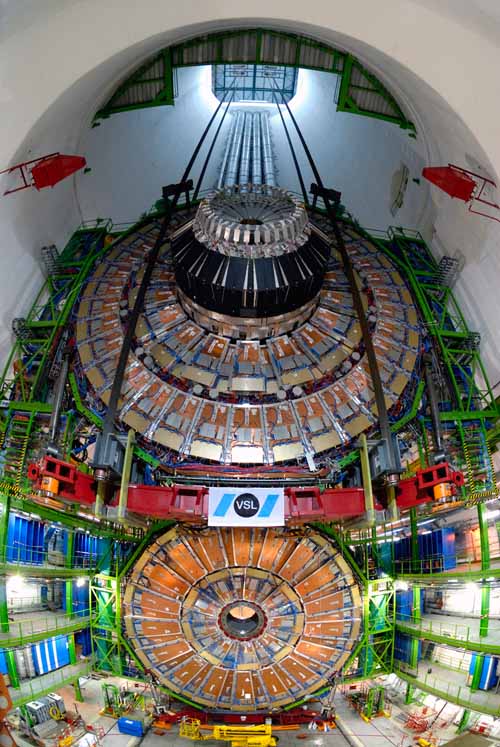
The Large Hadron Collider (LHC) is a particle accelerator of the
European Organization for Nuclear Research (CERN) that lies
under the Franco-Swiss border near Geneva, Switzerland. The LHC
is in the final stages of construction and commissioning, with
some sections already being cooled down to their final operating
temperature of approximately 2K. The first beams are due for
injection mid June 2008 with the first collisions planned to
take place 2 months later. The LHC will become the world's
largest and highest-energy particle accelerator. The LHC is
being funded and built in collaboration with over two thousand
physicists from thirty-four countries as well as hundreds of
universities and laboratories.
When activated, it is theorized that the collider will
produce the elusive Higgs boson, the observation of which could
confirm the predictions and "missing links" in the Standard
Model of physics and could explain how other elementary
particles acquire properties such as mass. The verification of
the existence of the Higgs boson would be a significant step in
the search for a Grand Unified Theory, which seeks to unify
three of the four known fundamental forces: electromagnetism,
the strong nuclear force and the weak nuclear force, leaving out
only gravity. The Higgs boson may also help to explain why
gravitation is so weak compared to the other three forces. In
addition to the Higgs boson, other theorized novel particles
that might be produced, and for which searches are planned,
include strangelets, micro black holes, magnetic monopoles and
supersymmetric particles.
Technical Design
The collider is contained in a circular tunnel with a
circumference of 27 kilometres (17 mi) at a depth ranging from
50 to 175 metres underground. The tunnel, constructed between
1983 and 1988, was formerly used to house the LEP, an
electron-positron collider.
The 3.8 metre diameter, concrete-lined tunnel crosses the
border between Switzerland and France at four points, although
most of its length is inside France. The collider itself is
underground, with surface buildings holding ancillary equipment
such as compressors, ventilation equipment, control electronics
and refrigeration plants.
The collider tunnel contains two pipes, each pipe containing
a beam. The two beams travel in opposite directions around the
ring. 1232 dipole magnets keep the beams on their circular path,
while additional 392 quadrupole magnets are used to keep the
beams focused, in order to maximize the chances of interaction
between the particles in the four intersection points, where the
two beams will cross. In total, over 1600 superconducting
magnets are installed, with most weighing over 27 tonnes. 96
tonnes of liquid helium is needed to keep the magnets at the
operating temperature.
The protons will each have an energy of 7 TeV, giving a total
collision energy of 14 TeV. It will take less than 90
microseconds for an individual proton to travel once around the
collider. Rather than continuous beams, the protons will be
"bunched" together, into 2,808 bunches, so that interactions
between the two beams will take place at discrete intervals
never shorter than 25 ns apart. When the collider is first
commissioned, it will be operated with fewer bunches, to give a
bunch crossing interval of 75 ns. The number of bunches will
later be increased to give a final bunch crossing interval of 25
ns.
Prior to being injected into the main accelerator, the
particles are prepared through a series of systems that
successively increase the particle energy levels. The first
system is the linear accelerator Linac 2 generating 50 MeV
protons which feeds the Proton Synchrotron Booster (PSB).
Protons are then injected at 1.4 GeV into the Proton Synchrotron
(PS) at 26 GeV. Finally the Super Proton Synchrotron (SPS) is
used to increase the energy of protons up to 450 GeV.
The LHC will also be used to collide lead (Pb) heavy ions
with a collision energy of 1,150 TeV. The ions will be first
accelerated by the linear accelerator Linac 3, and the
Low-Energy Injector Ring (LEIR) will be used as an ion storage
and cooler unit. The ions then will be further accelerated by
the Proton Synchrotron (PS) and Super Proton Synchrotron (SPS)
before being injected into LHC ring, where they will reach an
energy of 2.76 TeV per nucleon. Six detectors are being
constructed at the LHC, located underground in large caverns
excavated at the LHC's intersection points. Two of them, ATLAS
and CMS, are large, "general purpose" particle detectors.
ALICE is a large detector designed to study the properties of
quark-gluon plasma looking at the debris of heavy ion
collisions. The other three (LHCb, TOTEM, and LHCf) are
relatively smaller and more specialized. A seventh experiment,
FP420 (Forward Physics at 420m), has been proposed which would
add detectors to four available spaces located 420m on either
side of the ATLAS and CMS detectors.
The size of the LHC constitutes an exceptional engineering
challenge with unique safety issues. While running, the total
energy stored in the magnets is 10 GJ, while each of the two
beams carries an overall energy of 362 MJ. For comparison, 362
MJ is the kinetic energy of a TGV running at 157 km/h (98 mph),
while 724 MJ, the total energy of the two beams, is equivalent
to the detonation energy of approximately 173 kilograms (380 lb)
of TNT, and 10 GJ is about 2.4 tons of TNT. Loss of only 10-7 of
the beam is sufficient to quench a superconducting magnet, while
the beam dump must absorb an energy equivalent to a typical
air-dropped bomb.
These immense kinetic energies become far more spectacular
when you consider how little matter is carrying it. At its
maximum energy rating (2.76TeV per particle with a total of
362MJ), there is just 1.15E-9 grams of hydrogen in the system
(or 0.026 of one cubic millimeter).
Research
When in operation, about seven thousand scientists from
eighty countries will have access to the LHC, the largest
national contingent of seven hundred being from the United
States. Physicists hope to use the collider to test various
grand unified theories and enhance their ability to answer the
following questions:
- Is the popular Higgs mechanism for generating elementary
particle masses in the Standard Model realised in nature? If
so, how many Higgs bosons are there, and what are their
masses?
- Will the more precise measurements of the masses of the
quarks continue to be mutually consistent within the Standard
Model?
- Do particles have supersymmetric ("SUSY") partners?
- Why are there apparent violations of the symmetry between
matter and antimatter?
- Are there extra dimensions indicated by theoretical
gravitons, as predicted by various models inspired by string
theory, and can we "see" them?
- What is the nature of dark matter and dark energy?
- Why is gravity so many orders of magnitude weaker than the
other three fundamental forces?
A simulated event in the CMS detector,
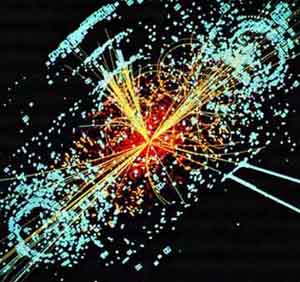
featuring the appearance of the
Higgs boson.
Proton-Proton Collisions at the LHC
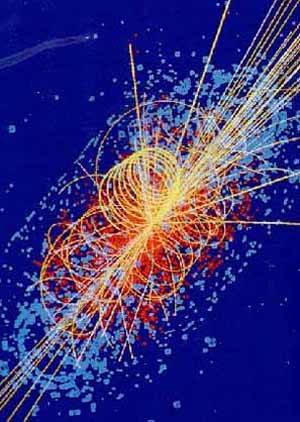
Computer reconstruction of particle tracks, originating
from the simulated decay of a Higgs boson.
LHC as an ion collider
The LHC physics program is mainly based on proton-proton
collisions. However, shorter running periods, typically one
month per year, with heavy-ion collisions are included in the
programme. While lighter ions are considered as well, the
baseline scheme deals with lead (Pb) ions. This will allow an
advancement in the experimental programme currently in progress
at the Relativistic Heavy Ion Collider (RHIC).
Proposed Upgrade
After some years of running, any particle physics experiment
typically begins to suffer from diminishing returns; each
additional year of operation discovers less than the year
before. The way around the diminishing returns is to upgrade the
experiment, either in energy or in luminosity.
A luminosity upgrade of the LHC, called the Super LHC, has
been proposed, to be made after ten years of LHC operation. The
optimal path for the LHC luminosity upgrade includes an increase
in the beam current (i.e., the number of protons in the beams)
and the modification of the two high luminosity interaction
regions, ATLAS and CMS. To achieve these increases, the energy
of the beams at the point that they are injected into the
(Super) LHC should also be increased to 1 TeV. This will require
an upgrade of the full pre-injector system, the needed changes
in the Super Proton Synchrotron being the most expensive.
Micro black holes
Although the Standard Model of particle physics predicts that
LHC energies are far too low to create black holes, some
extensions of the Standard Model posit the existence of extra
spatial dimensions, in which it would be possible to create
micro black holes at the LHC at a rate on the order of one per
second. According to the standard calculations these are
harmless because they would quickly decay by Hawking radiation.
The concern is that among other disputed factors, Hawking
radiation (the existence of which is still debated) is not yet
an experimentally-tested or naturally observed phenomenon.
The opponents to the LHC consider that micro black holes
produced in a terrestrial laboratory might not decay as rapidly
as calculated, or might even not be prone to decay. According to
CERN, physicists in general do not question the assumption that
black holes are generally unstable and those few who have
pointed out issues with Steven Hawking's radiation were only
attempting to achieve a more rigorous proof of it.[30] "No-one
ever claimed that his proof of the decay is wrong, and that
therefore they should be stable." CERN further argues that even
if micro black holes were created and were stable, they would
pose no reasonable threat to the Earth during its remaining 5
billion years of existence. However, Dr. Adam D. Helfer's thesis
concludes "no compelling theoretical case for or against
radiation by black holes", and Dr. Otto E. Rossler's thesis
calculates that Earth accretion time could be as short as 50
months.
Strangelet
A strangelet or "strange nugget" is a hypothetical object
consisting of a bound state of roughly equal numbers of up,
down, and strange quarks. The size could be anything from a few
femtometers across (with the mass of a light nucleus) to
something much larger. Once the size becomes macroscopic (on the
order of meters across), such an object is usually called a
quark star or "strange star" rather than a strangelet. An
equivalent description is that a strangelet is a small fragment
of strange matter. The term "strangelet" originates with E.
Farhi and R. Jaffe. Strangelets have been suggested as a dark
matter candidate.
Resources
Large Hadron Collider Wikipedia
 Large Hadron Collider YouTube -- Watch
Michio Kaku
Large Hadron Collider YouTube -- Watch
Michio Kaku
Large Hadron Collider Google Images
LHC - Large Hadron Collider CERN
Large Hadron Collider Website
Images
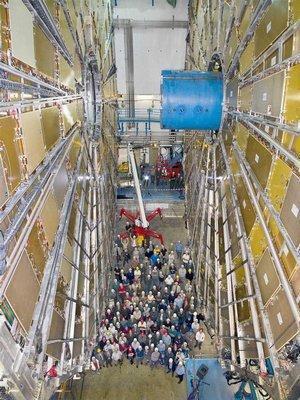
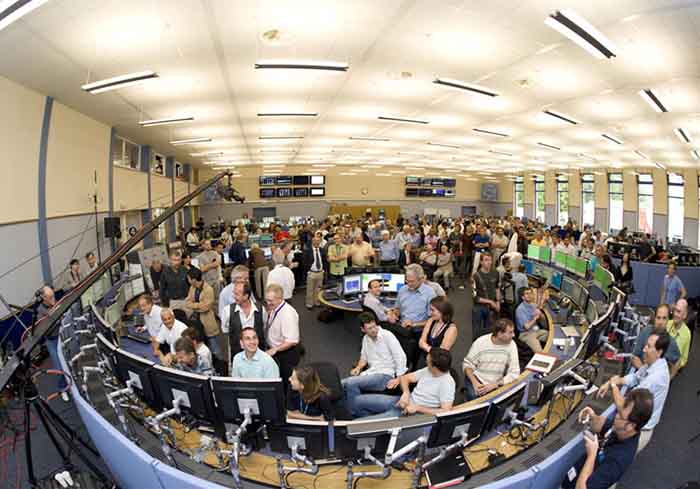
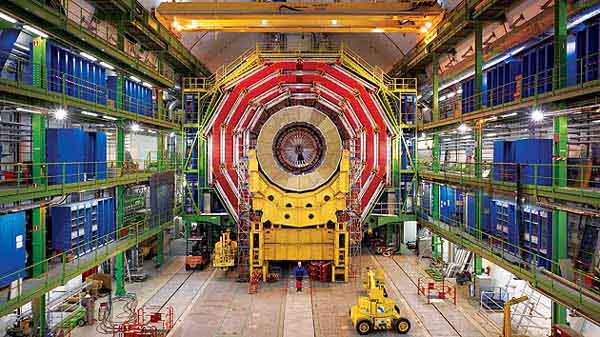
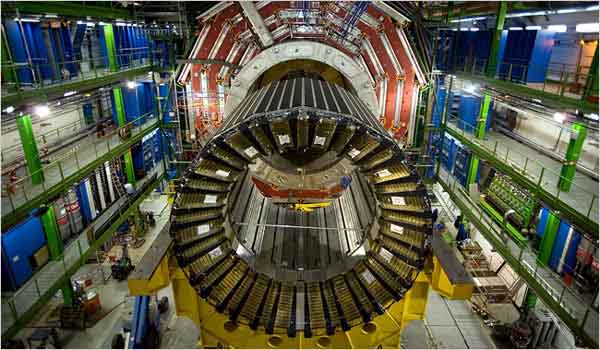
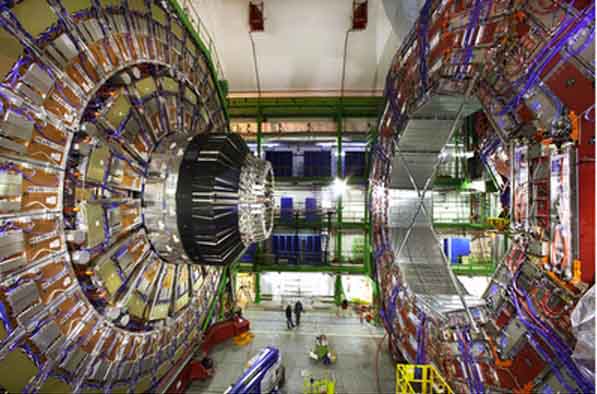
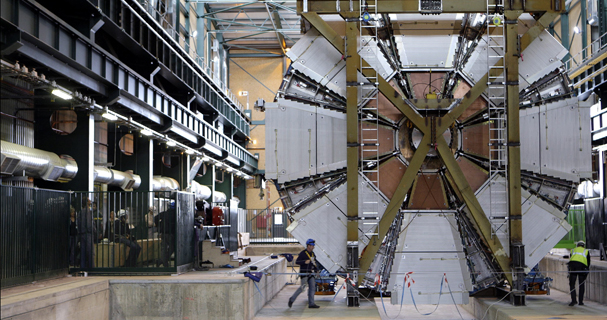
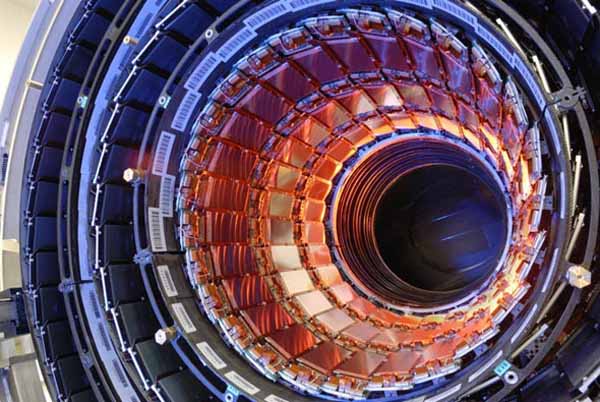
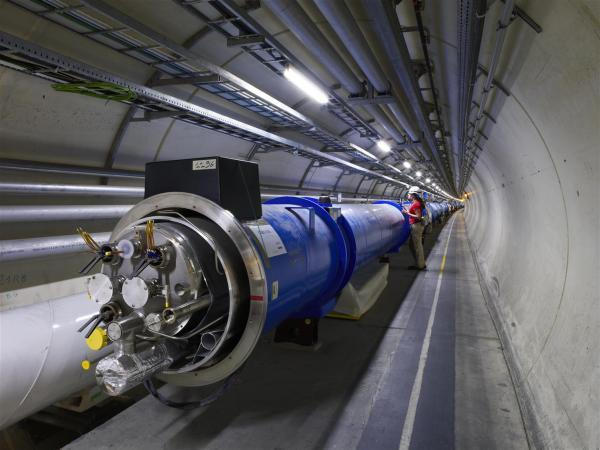
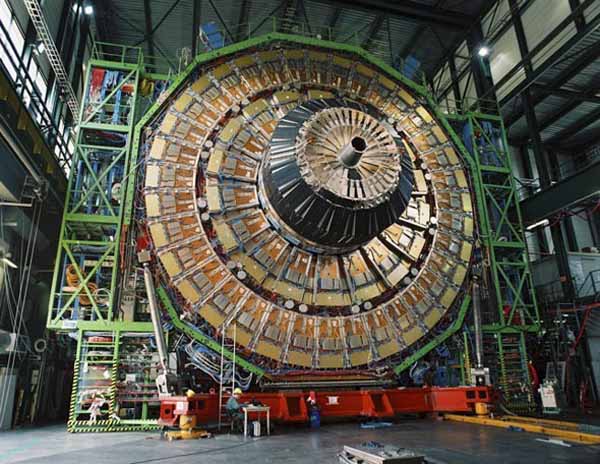
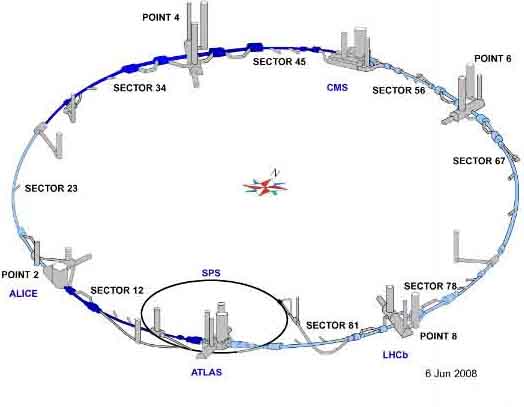
In the News ...
Large Hadron Collider Enables Hunt For 'God' Particle To
Complete 'Theory Of Everything' Science Daily - June 1, 2008
When the world's most powerful subatomic particle collider
begins gathering data this summer ... Hopefully it will help
unlock some deep scientific mysteries and perhaps even lead to
discovery of the
Higgs boson, sometimes called "the God particle" because it
is believed its discovery will refine the understanding of
exactly how the universe came to be and how it functions, and
how mass came to be in the first place.
LHC: Amazing Images National Geographic - March 2008
The God Particle - Higgs Boson National Geographic - March
2008
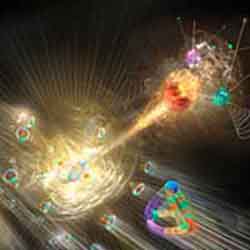
Could the Large Hadron Collider destroy Earth?
By Chris Gaylord |
07.01.08
Now that the European Large Hadron Collider (LHC) is
completed and ready to fire up in August, a slew of
articles have popped up quoting doomsayers. An
AP article from this weekend was the most recent
example of critics warning that the 17-mile, $5.8 billion
supercollider – which will slam protons together in an
attempt to learn more about the building blocks of the
universe – will inadvertently create a black hole that
will gobble up the Earth.
So, will the most ambitious science project in human
history end human history? No.
I should say “no, according to scientists working on
the LHC.” But the evidence points to a resounding “no.”
A study released last month
disassembled the arguments against powering up the
collider. The report found “no basis for concerns that
[small] black holes from the LHC could pose a risk to
Earth on timescales shorter than the Earth’s natural
lifetime.” In other words: Yes, it could happen, but
chances are the sun will burn out before this collider can
have an Earth-ending mishap.
Their reasoning?
Slashdot puts it best:
“Everything that will be created at the LHC is already
being created by cosmic rays. If a black hole created by
the LHC is interactive enough to destroy the world within
the lifetime of the sun, similar black holes are already
being created by cosmic rays.”
If such black holes were naturally flinging around
in the universe, they would bump up against “dense
cosmic objects,” such as neutron stars, and over time
the black holes would swallow the star. But, from looking
through telescopes we know that there are plenty of old
neutron stars around. So, if it’s safe for them, it’s also
safe for us. “Any black hole that could be created at the
LHC, even if it is stable, would have no effect on the
earth on any meaningful timescale,” Slashdot says.
This conclusion is backed by the European agency
that runs the LHC, a panel of independent scientists, the
US Department of Energy, the US National Science
Foundation, and science star Stephen Hawking – who argues
that even if black holes developed, “they would instantly
evaporate.”
That’s good enough for me.
The Truth About Microscopic Black Holes and the Utter
Destruction of Earth
Science fiction is rife with tales of
experiments that run out of control and blow
up the planet or exterminate all life or
something. Maybe that's why two U.S.
researchers sued the European Organization for
Nuclear Research (CERN), trying to get an
injunction that would prevent them from
building their
Large Hadron Collider. Their reason?
Concern that it would create an apocalyptic
mini-black
hole here on Earth. Many debated whether
their fears were pure cranksterism or held a
grain of truth. Now a physics professor has
researched the issue and discovered the truth
about the LHC's inherent risks to all
humanity.The Large Hadron Collider,
once operational, will fire beams of protons
into each other at energy levels never seen on
Earth. We don't really know what will happen
when experiments begin (or we wouldn't bother
running the experiments), and there are fears
that all kinds of weird, hypothetical
particles could be created that will devour
the planet, or that a small but stable black
hole will begin consuming all nearby matter.
Steve Giddings, Professor of Physics at UC
Santa Barbara, studied the risks. His
conclusions:
- The chances of a microscopic black
hole forming are impossibly small.
- Cosmic rays smash into particles all
the time at very high energies. We probably
would have noticed if the universe was being
chewed up by an endless torrent of ravenous
mini black holes.
- In the incredibly unlikely event that
a microscopic black hole forms, it would
exist for "a nano-nano-nanosecond." Not long
enough to do any damage, in other words.
Giddings even studied what would
happen if a long chain if bizarre events
occurred, and a stable micro black hole
formed. The result would be...nothing much.
Even a stable microscopic black hole would
be harmless.
|
Earth 'not at risk' from collider
|
|
By Paul Rincon
Science reporter, BBC News
|

June 23, 2008
Our planet is not at risk from the
world's most powerful particle physics experiment, a
report has concluded.
The document addresses fears that the Large
Hadron Collider is so energetic, it could have
unforeseen consequences.
Critics are worried that mini-black holes made
at the soon-to-open facility on the French-Swiss
border might threaten the Earth's very existence.
But the report, issued the European Organization
for Nuclear Research, says there is "no conceivable
danger".
The organization - known better by its French
acronym, Cern - will operate the collider underground
in a 27km-long tunnel near Geneva.
This Large Hadron Collider (LHC) is a powerful
and complicated machine, which will smash together
protons at super-fast speeds in a bid to unlock the
secrets of the Universe.
Six "detectors" - individual experiments - will
count, trace and analyse the particles that emerge
from the collisions.
Most physicists believe the risk of a cataclysm
lies in the realms of science fiction. But there have
been fears about the possibility of a mini-black hole
- produced in the collider - swelling so that it
gobbles up the Earth.
Critics have previously raised concerns that the
production of weird hypothetical particles called
strangelets in the LHC could trigger the mass
conversion of nuclei in ordinary atoms into more
strange matter - transforming the Earth into a hot,
dead lump.
New particles
The lay language summary of the report, which
has been written by Cern's top theorists, states:
"Over the past billions of years, nature has already
generated on Earth as many collisions as about a
million LHC experiments - and the planet still
exists."
The report added: "There is no basis for any
concerns about the consequences of new particles or
forms of matter that could possibly be produced by the
LHC."
The new document is an update of the analysis
carried out in 2003 into the safety of the collider by
an independent team of scientists.
The authors of the latest report, including
theoretical physicist John Ellis, confirmed that black
holes could be made by the collider. But they said:
"If microscopic black holes were to be singly produced
by colliding the quarks and gluons inside protons,
they would also be able to decay into the same
types
of particles that produced them."
The report added: "The expected lifetime [of a
mini-black hole] would be very short."
On the strangelet issue, the report says that
these particles are even less likely to be produced at
the LHC than in the lower-energy Relativistic Heavy
Ion Collider (RHIC) in New York, which has been
operating since 2000.
A previous battle over particle accelerator
safety was fought over the US machine.
'Fundamental question'
The scientific consensus appears to be on the
side of Cern's theorists.
But in 2003, Dr Adrian Kent, a theoretical
physicist at the University of Cambridge, wrote a
paper in which he argued that scientists had not
adequately calculated the risks of a "killer
strangelet" catastrophe scenario.
He also expressed concern that a fundamental
question (how improbable does a cataclysm have to be
to warrant proceeding with an experiment?) had never
been seriously inspected.
The LHC was due to switch on in 26 November
2007. The start-up has been postponed several times,
however, and is currently scheduled for later this
summer.
The first delay was precipitated by an accident
in March 2007 during stress testing of one of the
LHC's "quadrupole" magnets.
A statement carried on the Cern website from the
US laboratory that provided the magnet stated that the
equipment had experienced a "failure" when supporting
structures "broke".
It later emerged that the magnet had exploded in
the tunnel, close to one of the LHC's most important
detectors.
No one was in the immediate vicinity of the
test, so there were no injuries. The magnet problem
was fixed shortly afterwards.
In March, a complaint requesting an injunction
against the LHC's switch-on was filed before the
United States District Court for the District of
Hawaii by seven plaintiffs.
One of the plaintiffs had previously attempted
to bring a similar injunction against the RHIC over
safety concerns.
Paul.Rincon-INTERNET@bbc.co.uk
Atom Smasher Smashes Energy
Record
(March 19) -- From broken down to record
breaking, the Large Hadron Collider -- the
world's largest, most expensive particle
accelerator -- just achieved yet another
milestone on the quest to discover the secrets
of the physical universe.
Today,
scientists at the European Organization for
Nuclear Research, known as CERN, proudly
announced they had circulated the highest
energy particle beams ever produced by humans
around the LHC, and on their first attempt, no
less.
"It was incredible. I really
didn't expect it to go," said Mike Lamont, the
head of LHC machine operations, in a video
posted on the
CERN Web site. "Astounding. I mean,
I don't think anyone in their wildest dreams
expected us to go to 3.5 TeV. I think to do
that on the first try just shows us what a
beautiful machine we've got here."

Sean Gallup, Getty Images
The Large Hadron Collider, also known
as the "big bang machine," set a new
energy record on Friday, packing a
3.5-trillion electron-volt punch,
according to scientists at the
European Organization for Nuclear
Research.
The measurement Lamont refers to, "TeV,"
stands for "tera-electron
volts," a physics term that describes
the extremely small amount of kinetic energy
one particle gains when it is accelerated. In
reaching the new level of 3.5 TeV early this
morning, the LHC bested its own previous world
record of 0.18 TeV, achieved in November. By
contrast, 1 TeV is equal to the energy
produced by
a flying mosquito.
In two
years, CERN scientists aim to accelerate beams
of protons at twice as much energy around the
LHC, a 17-mile-long underground ring located
beneath the Swiss-French border near the city
of Geneva.
"A full 7 TeV beam contains
as much energy as a Royal Navy aircraft
carrier steaming at 12 knots," says
Lewis Page at The Register. "Once
the beams are up, that energy has to go
somewhere in the end: If a single magnet were
to fail, for instance, a terrific blast of
energy would leave the Collider's ring at that
point with consequences much the same as if
HMS Invincible had suddenly popped out of
nowhere and rammed the tunnel."
Acceleration is only the first part of the
much grander experimental process, however, as
CERN scientists then point the beams toward
one another inside the ring to create a
collision, which in turn will produce double
the amount of energy of each individual beam.
The first collisions of the two 3.5 TeV beams
(a 7 TeV total) are set to take place in the
coming weeks, according to CERN via
ZDNet.
When CERN scientists
finally achieve their goal of colliding two 7
TeV beams together next year, they hope to
observe in microcosm the same conditions that
existed immediately following the "big
bang," the widely held theory that the
universe emerged from a single, unimaginably
violent expansion of particles from one
superdense, superhot state some 12 billion to
15 billion years ago.
"As the universe
cooled and the temperature fell below a
critical value, an invisible force field
called the 'Higgs field' was formed together
with the associated 'Higgs boson' [particle],"
notes
CERN's Web site. "The problem is
that no one has ever observed the Higgs boson
in an experiment to confirm the theory."
One of CERN's ultimate objectives for the
LHC is to use it to definitively answer
whether such a particle exists or not, which
would result in either the confirmation or
refutation of the theoretical building blocks
of all modern physics. However, the
implications of locating the so-called "God
particle" have proven to be highly
unsettling to some in both the public and
scientific spheres.
A
widely
disseminated and erroneous fear is that
the LHC could produce a black hole capable of
destroying the Earth. Several individuals have
even filed
lawsuits against CERN in a bid to
stop work on the Large Hadron Collider for
this very reason.
In addition, since
its construction began in 1995, the LHC has
been beset by numerous unforeseen technical
obstacles, glitches and bizarre moments of
misfortune that have added at least $40
million to its total cost of
$4.3 billion, reports the
Telegraph.
The list of
errors is as long as it is strange: In 2005, a
technician was
killed by a falling crane. In 2007,
"there
was a serious failure in a high-pressure test"
of three focusing magnets inside the LHC.
Finally booted up in October 2008, the LHC was
quickly shut down again just a few weeks later
after an underground tunnel ruptured, flooding
the area with
a ton of liquid helium and causing
crucial magnets to overheat and fail. In 2009,
more leaks were found, further
delaying the project's timeline.
That
same year, one CERN scientist made headlines
after being arrested and charged with "criminal
association with a terrorist enterprise,"
in connection with al-Qaida. Finally, less
than a month later, a random bird somehow
managed to drop a "bit
of baguette" into the machine, causing
it to overheat and shut down.
The
sheer number and variety of problems
eventually led some in the scientific press to
speculate that a force from the
future or
God himself was deliberately
sabotaging the Large Hadron Collider to
prevent it from unleashing a great catastrophe
via its experiments.
However, since
being turned back on in November, the LHC has
performed "almost
flawlessly," according to The
Associated Press.
The latest energy
achievement also kicks off what is to be the
LHC's longest period of continual operation.
CERN says it will remain on and accelerating
for the next 18 to 24 months. By the end of
2010, however, it will be shut down for a
short period of maintenance. And then again,
in 2011, it will be
turned off for a whole year to
undergo more extensive repairs.
Filed under:
World,
Science
CERN: 2015
NOW!
Christians are worried that colliding
particles at CERN is going to open up a portal
or doorway into another dimension, and let
"something" in OR suck "something" out, and we
won't be able to close that doorway again.
There are tons of videos on You Tube about
CERN, the giant particle accelerator that is
supposedly to finally be turned on September
23rd, 2015. Most of these videos are so biased
– many through the lens of religious dogma –
that they don’t supply much true information.
TOM HORN INFORMATION
Tom
Horn discusses with Steve Quayle in a
televised edition they talk about CERN and the
search for gateways to other realms. Will
scientists find proof of other dimensions? Do
they plan to make war with God Himself!
The CERN is a demonic tool that will rip open
a portal to the under world which will cause
all fallen angels and demons to walk on earth
once again. Matthew
15:14 Let them alone: they be
blind leaders of the blind. And if the blind
lead the blind, both shall fall into the
ditch. Luke
6:39 And he spake a parable unto
them, Can the blind lead the blind? shall they
not both fall into the ditch?
TOM HORN AND CHRIS PUTNAM - THE MYSTERIES OF
CERN AND THE UNKNOWN
http://jimbakkershow.com/video/the-mysteries-of-cern-and-the-unknown/
https://socioecohistory.wordpress.com/2015/05/13/tom-horn-the-secrets-of-the-cern-stargate/
TOM HORN, CHRIS PUTNAM
AND JIM BAKKER
https://www.youtube.com/watch?v=V2tqa4auLWw
TOM HORN - OPENING THE
PORTALS TO HELL -
https://www.youtube.com/watch?v=gUVAW3KfzNE
TOM HORN AND STEVE QUAYLE - CERN AND
FORBIDDEN GATES
https://www.youtube.com/watch?v=gbo-kRTbpYQ
PART 4
https://www.youtube.com/watch?v=-adgSd_645I
|
The newest connections to DynCorp,
Hadron and PROMIS software are leads an
...... Hadron describes itself as “a
company specializing in the development of
...
www.greatdreams.com/microbiologists.htm
|
|
1980, The Inner Structure of the
Proton, describing photons, their
breakdown into quarks, hadron jets, matter
and antimatter opposites and as stated in
the ...
www.greatdreams.com/grace/1/1photons.html
|
Objects made up of quarks are known as
hadrons; well known examples are protons
... Further on, Jerry Iuliano comments
that the top quark (hadron) is the ...
www.greatdreams.com/grace/126/143invisibleuni.html
STEPHEN HAWKING COMMENTS
Respected physicist Stephen Hawking has
warned the end of the world could be
sparked by the elusive ‘God particle’.
The Cambridge-educated cosmologist said
the Higgs boson could become unstable at
very high energy levels and have the
potential to destroy the universe. Mr
Hawking said it would lead to a
“catastrophic vacuum decay” which would
cause space and time to collapse and
that we would NOT have any warning to
the danger. The eminent scientist added
that the armageddon scenario could
happen at any time. Speaking in the
preface to a new book called Starmus, Mr
Hawking said: “The Higgs potential has
the worrisome feature that it might
become megastable at energies above
100bn giga-electron-volts (GeV). This
could happen at any time and we wouldn’t
see it coming. “This could mean that the
universe could undergo catastrophic
vacuum decay, with a bubble of the true
vacuum expanding at the speed of light.
This could happen at any time and we
wouldn’t see it coming.
The Cambridge-educated cosmologist said
the Higgs boson could become unstable at
very high energy levels and have the
potential to destroy the universe.
Mr Hawking said it would lead to a
"catastrophic vacuum decay" which would
cause space and time to collapse and
that we would NOT have any warning to
the danger
The eminent scientist added that the
armageddon scenario could happen at any
time.
Speaking in the preface of
a new book called 'Starmus', Mr Hawking
aid, "The Higgs potential has the
worrisome feature that it might become
megastable at energies above 100bn
giga-electron-volts (GEV)
"This
could mean that the universe could
undergo catastrophic vacuum decay, with
a bubble of the true vacuum expanding at
the speed of light. This could
happen at any time and we wouldn't see
it coming.
The Higgs boson was
discovered in 2012 by scientists at
CERN, who operate the world's largest
particle physics laboratory.
Also
known as the God particle, it was found
by accelerating two beams of protons in
opposite directions and then smashing
them together.
It was name after
British physicist Peter Higgs who
predicted its existence in 1964.
Mr Hawking, 72, did say the likelihood
of such a disaster is unlikely to happen
in the near future.
NOTE: STARMUS
COMES FROM THIS SOURCE
TOPIC:
PULSARS MAKE MUSIC
I watched
a documentary the other day about
Pulsars, and the Hubble Telescope
showed images of pulsars spinning
and then let us hear the beats and
sounds of different kinds that they
made that nobody in space can hear,
but our technology can listen in
on. It was just phenomenal.
Then I found out that there was
a star music festival in Tenerife
last July, 2012, and here is a
little something from that.
the star music
Brian May and Edgar Froese with
Tangerine Dream
https://www.youtube.com/watch?v=GyiKD3YUEDI
LAST HORIZON https://www.youtube.com/watch?v=frube9ra07Y
http://www.greatdreams.com/blog-2012/dee-blog100.html
MUSICAL PULSARS
|
MORE ABOUT THE HADRON COLLIDER AT CERN
DREAMS OF THE
GREAT EARTHCHANGES - MAIN INDEX
|
|
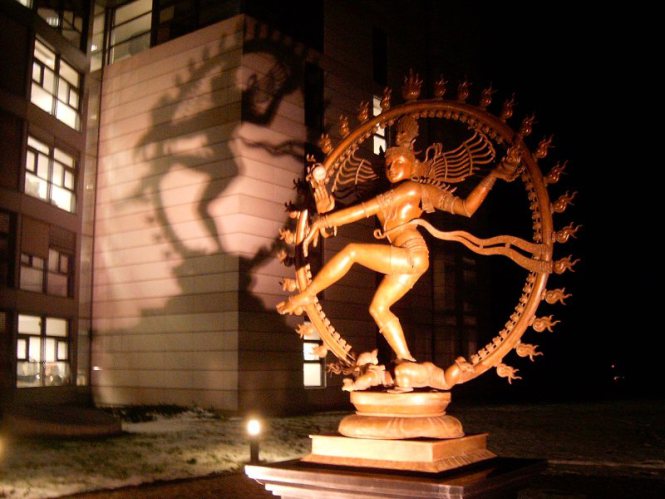
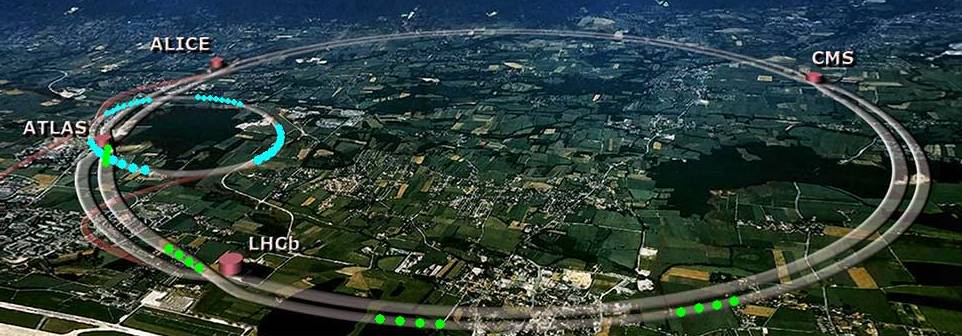
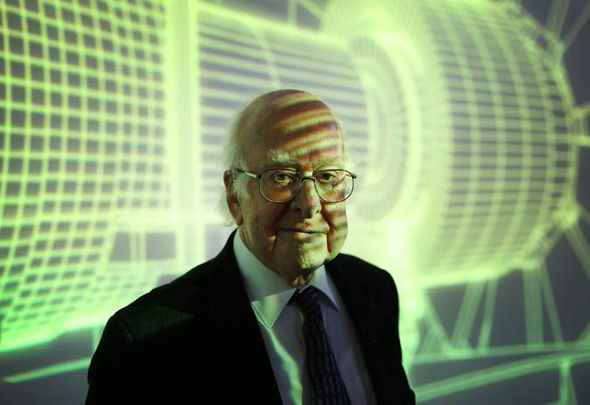
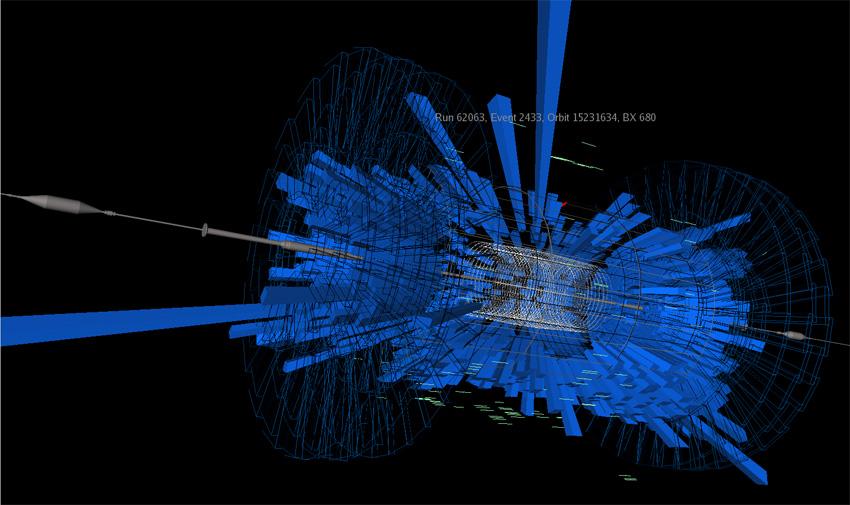
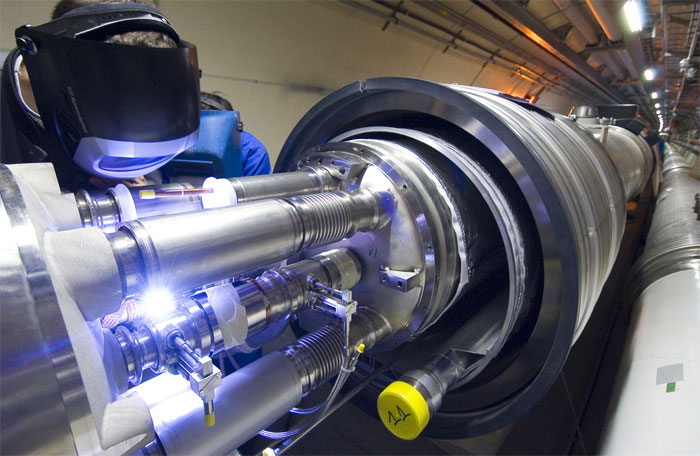
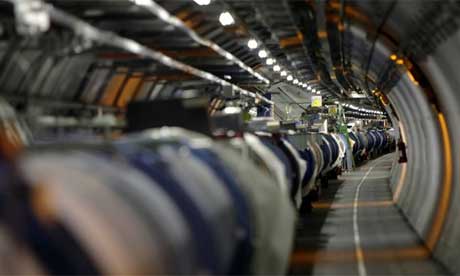
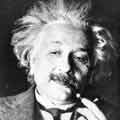

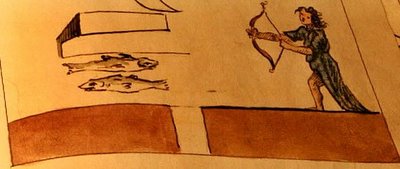















4 comments:
The upcoming Large Hadron Collider (LHC) at CERN could be dangerous. It could produce potentially dangerous particles such as mini black holes, strangelets, and monopoles.
A CERN study indicates no danger for earth, [Ref. 1] but its arguments are incomplete. The reasons why they are incomplete are discussed here.
This paper considers mainly micro black holes (MBHs) with low speeds. The fact that the speed of resultant MBHs would be low is unique to colliders. An important issue is the rate of accretion of matter subsequent to MBH creation.
This study explores processes that could cause accretion to be significant.
Other dangers of the LHC accelerator are also discussed.
I. Arguments for danger in LHC particle accelerator experiments
"In the 27-kilometer-long circular tunnel that held its predecessor, the LHC will be the most powerful particle accelerator in the world. It will smash fundamental particles into one another at energies like those of the first trillionth of a second after the Big Bang, when the temperature of the Universe was about ten thousand trillion degrees Centigrade." [Ref. 5]
1. There is a high probability that micro black holes (MBHs) will be produced in the LHC. A reasonable estimation of the probability that theories with (4+d) dimensions are valid could be more than 60%. The CERN study indicates in this case a copious production of MBHs at the LHC. [Ref. 1] One MBH could be produced every second. [Ref. 4 & Ref. 5]
2. The CERN study indicates that MBHs present no danger because they will evaporate with Hawking evaporation. [Ref. 1] However, Hawking evaporation has never been tested. In several surveys, physicists have estimated a non trivial probability that Hawking evaporation will not work. [Ref. 9] My estimate of its risk of Hawking evaporation failure is 20%, or perhaps as much as 30%.
The following points assume MBH production, and they assume that Hawking evaporation will fail.
3. The cosmic ray model is not valid for the LHC. It has been said that cosmic rays, which have more energy than the LHC, show that there is no danger. This may be true for accelerators that shoot high energy particles at a zero speed target. This is similar to cosmic ray shock on the moon's surface. In these cases the center of mass of interaction retains a high speed. This is different from the situation at the LHC, where particles with opposing speeds collide. With cosmic rays (mainly protons in cosmic rays) we need a speed of 0.9999995 c to create a micro black hole of 1 TeV and after the interaction the micro black hole center of mass will have a speed of 0.999 c. As MBHs are not very reactive with matter, calculations indicate that this is more than enough velocity to cross planets or stars without being caught and to escape into space.
4. Lower speed MBHs created in colliders could be captured by earth. Using Greg Landsberg's calculation [Ref. 3] of one black hole with velocity less than escape velocity from earth produced every 10^5 seconds at the LHC, we have 3.160 (US notation 3,160) MBHs captured by earth in ten years. More precise calculations show that we could have a distribution of MBHs at every range of speed from 0 m/sec to 4 m/sec. The probability of very low speed MBHs is not zero. We need to evaluate if low speed MBHs present more risks.
5. The speed of a MBH captured by earth will decrease and at the end MBHs will come to rest in the center of earth. The speed will decrease because of accretion and interaction with matter.
If we consider that:
a. The CERN study's calculus for accretion uses the "Schwarzschild radius" for the accretion cross section. [Ref. 1] In the case of low speeds, we must not use the Schwarzschild radius for the calculus of accretion. There are several reasons the capture radius extends beyond the Schwarzschild radius. For example, if the MBH speed were zero, gravitational attraction would be active at a distance greater than the Schwarzschild radius.
b. If a MBH accretes an electron, it will acquire a charge and then probably accrete a proton.
c. If a MBH accretes a quark it will then probably accrete a proton. When a quark is caught, the whole nucleon can be expected to be caught because otherwise the black hole would have acquired a charge which is not complete. (For example minus 1/3.) In a nucleus a fractional charge is unstable and is not allowed. This strongly suggests that the MBH will be required to accrete other divided charges to reach a completed integer number of charges. The same process can be expected in regard to quark color.
d. Gauge forces at short distances could also help to capture an atomic nucleus.
Our calculus indicates that a slow speed MBH can be expected to capture 8.400 (US notation 8,400) nucleons every hour, at the beginning of an exponential process.
6. In the center of earth new processes could occur: As stated above, it has been estimated that in ten years 3.160 (US notation 3,160) MBHs could be captured by earth. All MBHs will progressively lose speed because of numerous interactions. After a time (calculations have to be completed to estimate this time) all these MBHs will go toward the precise gravitational center of earth. (Kip Thorne [Ref. 7 p. 111]) After numerous interactions they will stop there at rest and then coalesce into a single MBH. To get an idea and for a first approach our calculus indicates that the mass of this MBH could be on the order of 0.02 g with a radius of 4 x 10^-17 m. At the center of earth, the pressure is 3.6 x 10^11 Pascals. [Ref. 8]. This pressure results from all the matter in Earth pushing on the electronic cloud of central atoms. The move of electrons is responsible of a pressure (called degenerescence pressure) that counterbalance the pressure of all the matter in Earth.
Around a black hole there is not an electronic cloud and there is no degenerescence pressure to counterbalance the pressure of all the Earth matter.To indicate the pressure we must use the surface If in an equation Pressure P = Force F / Surface S if we keep F= Constant and we reduce surface, we are obliged to notice that Pressure P will increase. Here F is the weight of all the matter of Earth and this do not change. As the surface of the MBH will be very small, calculus indicate on this surface an impressive increase of pressure in the range of : P = aprox 7 x 10 ^ 23 Pa .
The high pressure in this region push strongly all the matter in direction of the central point where the MBH is.
Electrons directly in contact with the Micro Black Hole will first be caught, then the nucleus will be caught.
It is sure that the atoms will be caught one after the other but the more the pressure will be important the more the caught will be quick. When a neutron star begins to collapse in a black hole (implosion), at the beginning the black hole is only a micro black hole as we see in [Ref. 7 Page 443]. At this very moment the high gravitational pressure in the center of the neutron star is there breaking the "strong force" which lays between the quarks located into the neutrons.
The MBH will grow there only because of the high pressure.
In center of Earth pressure is normally far to small for such a process, but if we create a slow speed MBH that does not evaporate and if this MBH comes at rest in the center of Earth, the pressure in the center of Earth could be sufficient for the growing of the MBH. We must remember that in the surrounding of the MBH the "strong force" is broken and this could mean that the same kind of pressure process than in neutron star could work there ( in a slow mode compared with a neutron star of course ). In the center of Earth, the high pressure, the high temperature, the increasing mass associated with electrical and gauge forces process could mean important increase of capture and a possible beginning of an exponential dangerous accretion process. Our calculus indicates as a first approximation with a MBH of 0.02 g at rest at the center of earth that the value for accretion of matter could be in the range of 1 g/sec to 5 g/sec.
7. Conclusion about MBHs : We estimate that for LHC the risk in the range of 7% to 10%.
II. Other Risk Factors
The CERN study indicates that strangelets and monopoles could be produced and present no danger for earth. [Ref. 1]
We will present arguments of possible danger.
1. Strangelets
Strangelets are only dangerous for earth if they are not moving rapidly through matter. If only one strangelet is at zero speed there would be danger. We have seen for MBHs that the cosmic ray model is very different from the LHC where particles with opposing speeds collide. We have seen that, given the impact of opposite speed particles, the distribution of speeds of resultant particles indicates the probability of very low speeds (0 m/sec < speed < 4 m/sec) and this could mean dangerous strangelets. We estimate a minimal risk for strangelets on the order of 2%. We might estimate as high as 10 % if we want to be wise because the danger is primary!
2. Monopoles
Monopoles could be produced in the LHC. [Ref. 1] .CERN's calculations indicate that one monopole produced in LHC could destroy 1.018 (US notation 1,018) nucleons but it will quickly traverse the earth and escape into space. However, we know that photons produced in the center of the sun need thousands of years to traverse the sun and escape into space because of the numerous interactions. If the speed given to the monopole after interaction is a speed in a random direction, we can imagine that the monopoles produced in the LHC could stay a very long time in earth and be dangerous. 3. Estimate of danger due to our ignorance of ultimate physical laws: We have not exhausted processes that might cause danger. There are other particles, black energy, black mass, quintessence, vacuum energy, and many non definitive theories. We estimate this danger ranging from a minimal 2% risk to 5%.
III. CONCLUSION
The CERN study [Ref. 1] is a remake of a similar study for the earlier Relativistic Heavy Ion Collider at Brookhaven (RHIC) [Ref. 6] adapted to the LHC.
It is important to notice that: The study for the RHIC had concluded that no black holes will be created. For the LHC the conclusion is very different: "Black holes could be created!" !
The main danger could be now just behind our door with the possible death in blood of 6.500.000.000 (US notation 6,500,000,000) people and complete destruction of our beautiful planet. Such a danger shows the need of a far larger study before any experiment ! The CERN study presents risk as a choice between a 100% risk or a 0% risk. This is not a good evaluation of a risk percentage!
If we add all the risks for the LHC we could estimate an overall risk between 11% and 25%!.
We are far from the Adrian Kent's admonition that global risks that should not exceed 0.000001% a year to have a chance to be acceptable. [Ref. 3] .Even testing the LHC could be dangerous. Even an increase in the luminosity of the RHIC could be dangerous! It would be wise to consider that the more powerful the accelerator will be, the more unpredicted and dangerous the events that may occur! We cannot build accelerators always more powerful with interactions different from natural interactions, without risk. This is not a scientific problem. This is a wisdom problem!
Our desire of knowledge is important but our desire of wisdom is more important and must take precedence. The precautionary principle indicates not to experiment. The politicians must understand this evidence and stop these experiments before it is too late!
Fausto Intilla -
http://www.oloscience.com
-----------------------------------------------------------------
References:
1.. Study of potentially dangerous events during heavy-ion collisions at the LHC: Report of the LHC Safety Study Group. CERN 2003-001. February 28, 2003.
2.. E-mail exchange between Greg Landsberg and James Blodgett, March 2003,
http://www.risk-evaluation-forum.org.
(No longer posted. Request a copy. Risk Evaluation Forum, BOX 2371, Albany, NY 12220 0371 USA.)
3.. A critical look at risk assessment for global catastrophes, Adrian Kent, CERN-TH 2000-029 DAMTP-2000-105. Revised April 2003. hep-ph/0009204. Available at:
http://arxiv.org/PS_cache/hep-ph/pdf/0009/0009204. ...
4.. High energy colliders as black hole factories: the end of short distance physics, Steven B. Giddings, Scott Thomas. Phys Rev D65 (2002) 056010.
5.. CERN to spew black holes, Nature October 2, 2001.
6.. Review of speculative disaster scenarios at RHIC September 28, 1999 W.Busza, R.L. Jaffe, J.Sandweiss and F.Wilczek.
7.. Trous noirs et distorsions du temps, Kip S. Thorne, Flammarion 1997. ISBN 2-08-0811463-X. Original title: Black holes and times warps. 1994 Norton. New York.
8.. Centre de la Terre, Science & Vie N 1042. Gallate 2004.
9.. Results of several Delphi groups and physicist questionnaires, James Blodgett, Risk Evaluation Forum, forthcoming.
Perhaps, speakeron, as a resident of Switzerland, you might tell us what the Swiss feel about the LHC. I get the impression from French media, there isn't much interest.
Could this article be somehow related to the prophecy about "Mars and Saturn are equally as fiery"?
http://www.space.com/spacewatch/080627-ns-mars-saturn.html
Their next meeting is set for July 30, 2010.
About Me
Alan Gillis Hi, I'm Alan Gillis. Glad you clicked in. THROUGH THE EYE OF ALAN GILLIS started with photos I took on walks and daytrips since 2005. It's the coffee table book backdrop to my life in Muskoka while I've been finishing UP ON SEVEN DOLLARS, an obsessional and satiric novel about Americans and Mexicans and tourists in Mexico. Dickens smashes into Lowry on the cover of ALARMA or a dazzling stylistic adventure. Any brilliant agents or editors in book publishing, email me. THE SCIENCE OF CONUNDRUMS was forced on me by science-based modern life which keeps on dwindling. Science journalism is mostly from the geewhiz school when it isn't rewrites of press releases. As a public service, I've tried to make Big Science comprehensible to anyone. With humor, at least people will read instead of skim. A year of university science premed opened some horizons into the scientific method. Most of my university years were spent on English Lit and Theater, Classics, Film and Photography. Add a lot of travel and fluency in French for perspective, and you can guess what I'm doing. --Alan GillisFROM: http://bigsciencenews.blogspot.com/2008/05/nostradamus-and-lhc.html